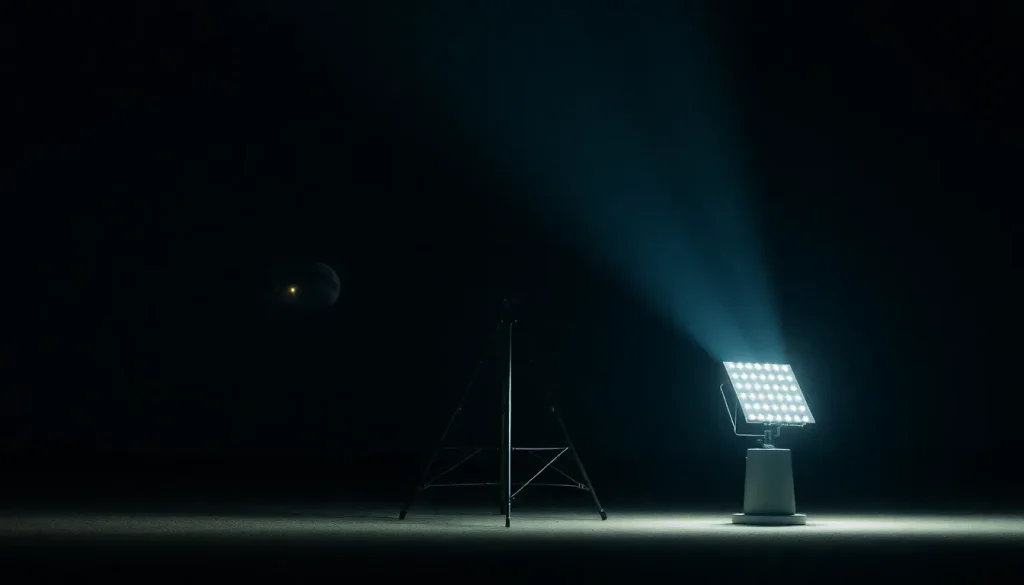Scientists aim to generate solar light at night, sparking debate

The quest for renewable energy has led to remarkable innovations, one of which is the harnessing of solar power. As the world shifts towards cleaner energy sources, scientists and companies are exploring unconventional methods to generate energy. One of the most ambitious ideas is to produce solar energy at night, a concept that raises both excitement and skepticism. How feasible is this idea, and what implications does it carry? Let's delve into the intricacies of generating solar energy on demand, particularly during the dark hours of the night.
- How do they plan to generate solar light on demand?
- Can solar panels operate at night?
- Unveiling the realities behind this experimental concept
- The growing concerns surrounding this satellite network
- What about nighttime solar radiation?
- What type of energy is needed for nighttime illumination in parks?
How do they plan to generate solar light on demand?
Reflect Orbital, an American company, is at the forefront of this innovative concept. Their approach is reminiscent of how a watch's glass reflects sunlight. However, instead of a small glass surface, they intend to deploy satellites equipped with massive mirrors, each measuring around 54 meters in diameter. These satellites will be positioned in orbit, aiming to reflect sunlight back to Earth even after sunset.
The first satellite is scheduled for launch in 2026, orbiting approximately 654 kilometers above the Earth. Given the angle of reflection needed to guide sunlight to specific locations, the effective distance could extend to around 800 kilometers.
The reflection of light from such a distance presents unique challenges. For instance, while a small mirror can focus sunlight into a bright point, larger distances mean that the intensity diminishes significantly. The light reflected by these satellites is estimated to be 15,000 times weaker than noon sunlight, which poses significant questions regarding its effectiveness in generating usable energy.
Can solar panels operate at night?
A common question arises: do solar panels work during nighttime? The straightforward answer is no; they rely on sunlight to generate electricity. However, this hasn't deterred innovators from seeking alternative methods. The concept of using satellites to reflect solar light back to Earth at night could theoretically provide a source of light, but the practicality of this endeavor is fraught with complications.
Unveiling the realities behind this experimental concept
Last year, Ben Nowack, the founder of Reflect Orbital, conducted a small-scale experiment to demonstrate the feasibility of their idea. He attached a 2.5-meter mirror to a balloon positioned 242 meters away from solar panels. His experiment successfully reflected light onto the panels, achieving an impressive average of 516 watts per square meter of energy. However, the leap from 242 meters to 800 kilometers introduces significant challenges. To replicate this success at such heights, much larger mirrors are needed—potentially mirrors measuring 6.5 kilometers in width.
To further complicate matters, estimates suggest that to reflect even 20% of noon sunlight, Reflect Orbital would need to deploy 3,000 satellites. Without this number, the energy generated remains insufficient. Even more staggering, to maintain a continuous hour of sunlight, around 100,000 satellites would be required. The question remains: is the vision of such a vast satellite network feasible or desirable?
The growing concerns surrounding this satellite network
The notion of deploying hundreds of thousands of satellites presents numerous challenges, not just in terms of technology but also regarding environmental impact. A constellation of satellites illuminating the night sky could lead to significant light pollution, disrupting both human and animal life. The long-term effects on ecosystems and natural behaviors are yet to be fully understood.
- Increased light pollution could disrupt nocturnal animals' feeding and breeding patterns.
- Astronomers may face severe difficulties due to interference from artificial light sources, potentially damaging their equipment and obscuring celestial observations.
- The accumulation of space debris from failed or decommissioned satellites poses a risk of collisions, which could jeopardize both current and future space missions.
Reflect Orbital asserts that they will communicate the timing of satellite operations to reduce interference with astronomical research. Yet, this proposal places an undue burden on scientists to adapt their work schedules around commercial interests. The impacts of constant lighting on human circadian rhythms and sleep patterns could also lead to long-term health issues.
What about nighttime solar radiation?
A lesser-known aspect of this discussion is the concept of nighttime solar radiation. Although solar panels do not operate at night, there is a phenomenon where solar energy can still be captured indirectly. For instance, certain materials can emit infrared radiation during the night, which some researchers are exploring as a potential energy source. However, this method is still in its infancy and requires extensive research before becoming a practical solution.
What type of energy is needed for nighttime illumination in parks?
In urban settings, lighting is crucial for safety and aesthetics. Parks and public spaces often rely on a combination of traditional electrical sources and renewable energy solutions. Solar-powered lights, equipped with batteries charged during the day, are increasingly common. These systems store energy to illuminate spaces at night without relying on external power sources.
- Solar streetlights: Charge during the day, provide light at night.
- LED lighting: Energy-efficient options that consume less power.
- Smart lighting systems: Adjust brightness based on surrounding light levels, conserving energy.
The focus on sustainability in urban planning emphasizes the importance of integrating renewable energy solutions. While the idea of generating solar light at night remains a captivating concept, practical implementations like solar streetlights present a more viable approach to nighttime illumination.
As the world continues to grapple with the challenges of climate change and energy demands, innovative ideas will undoubtedly emerge. However, the balance between ambition and feasibility must be carefully navigated to ensure that our pursuit of renewable energy does not lead to unintended consequences.
For those interested in exploring this topic further, check out this educational video that dives into the complexities and myths surrounding solar energy:


Leave a Reply